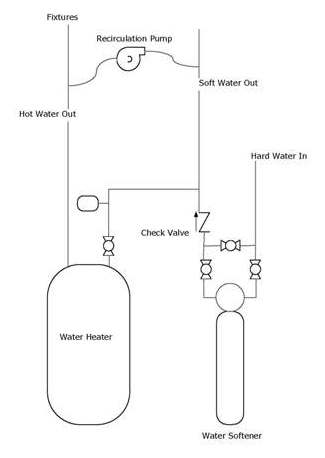You install a water softener for your customer. Years go by with uninterrupted, trouble-free performance. Your customer adds salt as directed, they have the system cleaned and disinfected every year by an authorized service provider; life is good and everyone is happy.
A few months after their most recent cleaning, disinfection, and preventative maintenance service the customer reports an interruption in their soft water. No big deal, it is a 10 year old system and probably needs a mechanical repair or resin augmentation… You dispatch a technician who determines that there is absolutely nothing wrong with the system. She cycles it, produces soft water and makes an adjustment to the efficiency setting on the system to accommodate for potential fluctuations in influent hardness….everyone’s happy for a week or two and then the client reports no soft water again!
You now dispatch a level 2 technician who checks every single faucet and fixture in the home to confirm no hard water crossovers… Everything is fine and he even opens the system to test the ion exchange resin and confirm the integrity of the valve/distributor interface. He short-cycles the system and produces glorious soft water! Customer is happy and the level 2 tech promises to return next week to follow-up.
No contact from the customer and the tech visits the home, expecting to be hailed as the conquering hero; none such luck. Client is friendly, bit firmly insistent that their water is not soft and they now doubt his ability to actually diagnose and repair softeners.Tech checks everything on the system again and it works fine mechanically again. Tech cycles the system completely and produces 800 gallons of soft water. Tech and customer are both confused now.
This is a rare situation that is fast becoming frustrating and costly. So what do we do?
A level 3 technician is dispatched to the home and looks at the problem holistically, assuming nothing; taking the time to evaluate the system as it operated through a partial regeneration cycle. He also carefully interviewed the homeowner about any recent changes in the home, such as new appliances, fixtures or plumbing repairs. He took detailed notes of what he saw:
- Influent Hardness – 30gpg
- Influent TDS – 580ppm
- Effluent Hardness Cold – 20gpg
- Effluent TDS Cold – 420ppm
- Effluent Hardness Hot – 19gpg
- Effluent TDS Hot – 940ppm
- Hardness after regeneration – 4gpg
- TDS after regeneration – 525ppm
- Influent pressure static – 32psi
- Influent pressure @ 5gpm flow – 20psi
He opened the brine tank and carefully inspected the air-check assembly for obstructions. He checked the safety brine valve assembly for proper functionality and air ingress. He checked all fittings to and from the softener and everything seemed to be within specifications. He placed the system into regeneration again, and closed the inlet supply valve on the 3-handle bypass….water continued to flow down the drain. Being a larger home, he assumed this to be normal and let it run. After 2 minutes, he deduced that this was NOT normal and began to look for causes of this anomalous situation. Stepping back in the mechanical room, he noticed that there was a newly installed hot water recirculation pump running on a timer. He unplugged the pump and the anomalous flow immediately stopped.
Hot water recirculation pumps are a great way to provide homeowners with fast access to hot water, and they are becoming more common as prices decrease and plumbers become more comfortable with new technologies. While fast hot water is great, recirculation pumps can present a distinct problem for any venturi-based water softening, conditioning, or filtration appliance when improperly sized or installed without consideration for the water tr eatment system.
eatment system.
The recirculation pump in this particular home was over-sized for the application, causing it to develop excessive pressure on the recirculation line which in turn forced water into the outlet of the water softener during regeneration.
When the water softener cleans, it relies on the venturi effect (passing a volume of fluid past an orifice to generate “vacuum”. This vacuum sucks regenerant fluid from the regenerant tank into the media bed to perform a cleaning or regeneration cycle. If the flow of water past the orifice is interrupted, there will be inadequate or intermittent vacuum, which can cause a host of complications.
This poor water softener was being intermittently exposed to pressure differentials that precluded it from regenerating properly, and also from adequately rinsing away the regeneration byproducts.
The fix to this situation was a simple check valve, installed immediately downstream of the softener before the hot water recirculation return line, preventing this problem from ever occurring again.
The devil is always in the details.